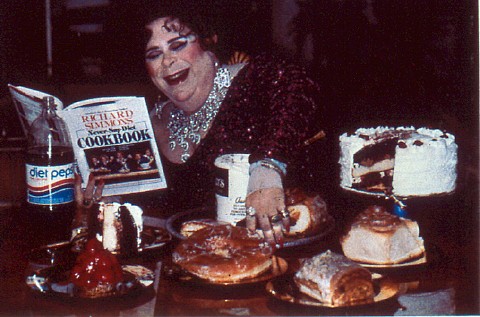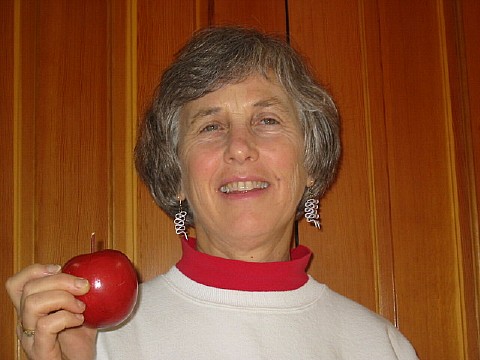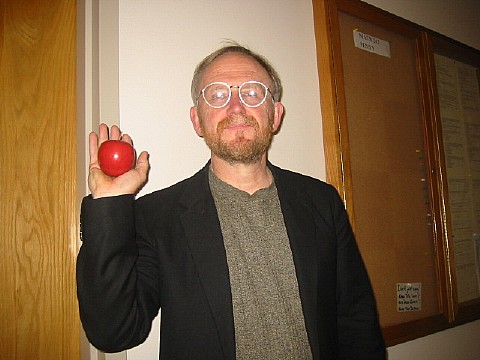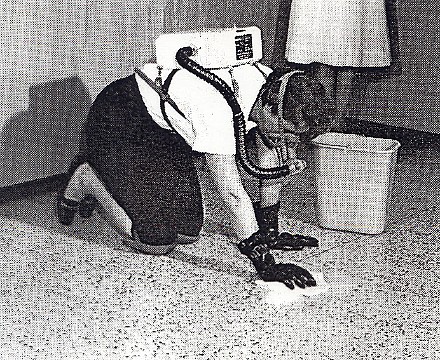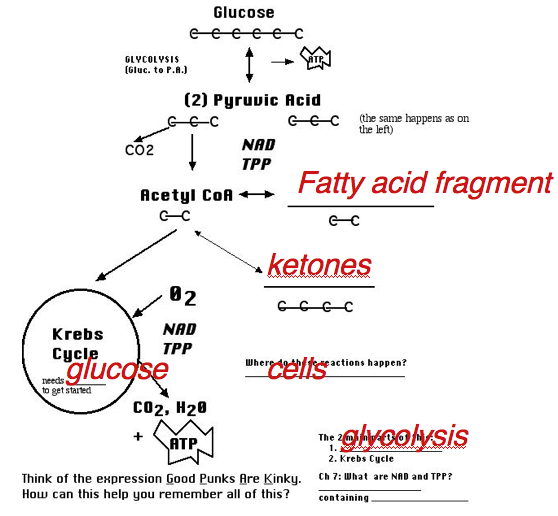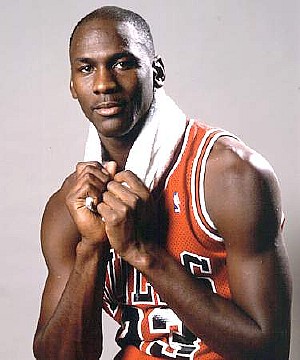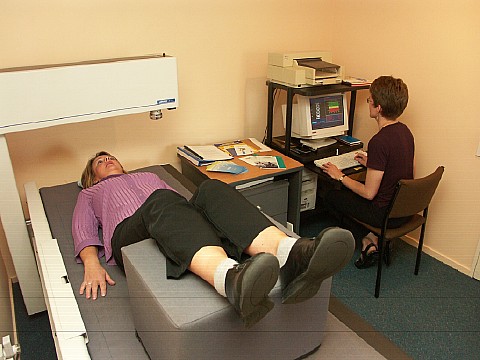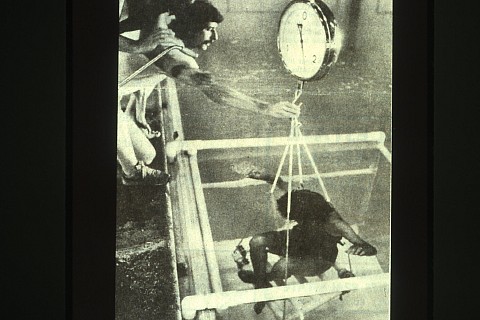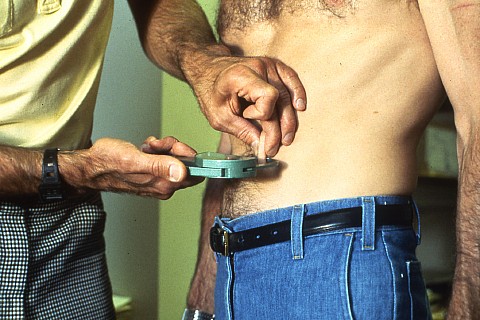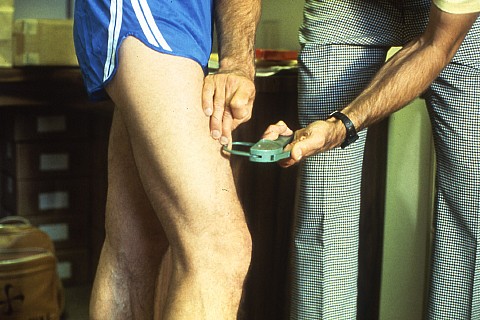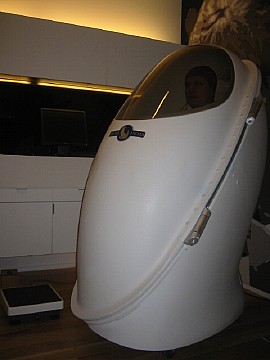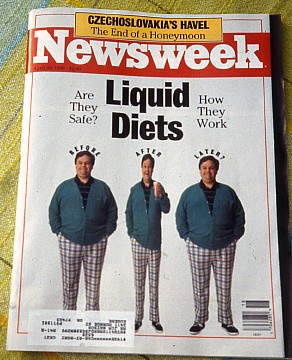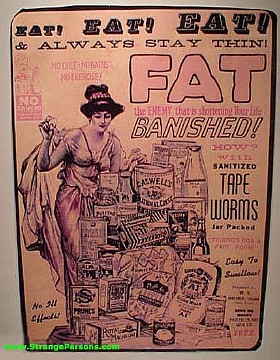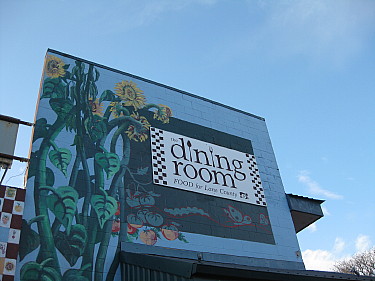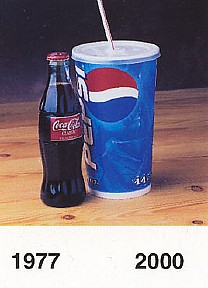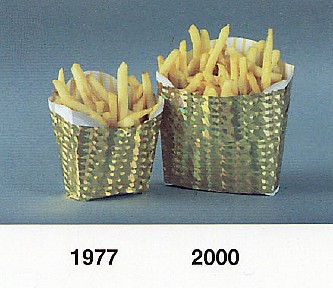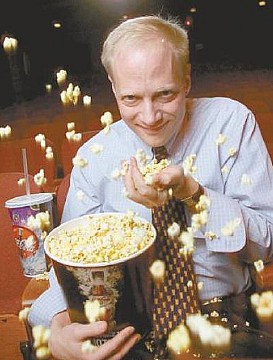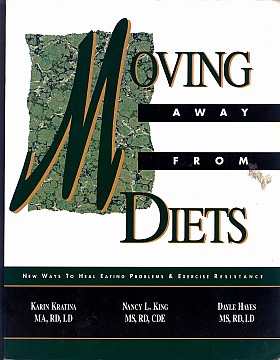|
VI
The Mystery of
Obesity: Inside
the body causes
There is considerable proof that much obesity is genetically
based. Partly using studies of twins separated at birth and
raised in two different households, numbers such as these have been
estimated:
o If 1
parent is obese, there is 60%
chance that the child will be heavy.
o If 2 parents are obese, there is 90%
chance that the child will be heavy
HOW GENES MIGHT PLAY A ROLE:
1. There
could be genetic variations in perceptions of hunger
and appetite.
As mentioned before, hunger is
the physical
need
to eat. Genes in fat cells direct the making of ghrelin, a
peptide hormone produced by stomach and small intestinal cells cells.
It is thought
to increase feelings of hunger
in order to stimulate eating.
Appetite
is the psychological desire
to eat creating satiety (feeling full). Genes in fat cells
direct the making of leptin, also
a peptide hormone, but one that is produced by adipose (fat)
cells. It plays
a role in body weight regulation by acting on the hypothalamus to
suppress appetite and burn fat stored in adipose tissue.
Perhaps the brain cells of obese people ignore these hormones,
just as some diabetics' cells (Type II diabetics) ignore insulin.
Eve Van Cauter, an endocrinologist at the
University of Chicago who is shown above, calls ghrelin
and leptin
the “yin and yang" of eating regulation.
In experiments by Van Cauter and
others, sleep-deprived adults produced more ghrelin,
a
hormone that
promotes hunger, and less leptin,
a
hormone that signals fullness.
The more your
genes direct the making of lipoprotein lipase enzyme (LPL), the more
easily fat cells store fat.
As page 326 in the text says, LPL is "an enzyme mounted on
the surface of fat cells that splits triglycerides in the blood
into fatty acids and glycerol to be absorbed into the cells for
reassembly and storage".
3. Genes regulate thermogenesis,
sometimes called the thermic effect of food (TEF). Some people's
genes may direct the expenditure of a lot of energy in thermogenesis,
producing abundant heat without performing any useful work.
There could be less of a TEF
happening in obese
people.
If you were a hunter-gatherer who lived in
a feast & famine situation, would you like to have a high TEF?
The
11th
edition of our text has an addition to Table 9.4 ("Selected
Theories of
Metabolic Causes of Obesity"). The text calls this theory "Fetal
programming theory" and here's what the text says:
The
children of mothers who either starved or were obese during their
pregnancies more often grew to be overweight or obese themselves.
An energy-lean or energy-rich prenatal environment may influence
fetal genetic expression for enzymes involved in energy metabolism:
the underfed fetus adapts by producing more energy-conserving
metabolic systems; the richly supplied fetus may adapt by producing
more fat-storing enzymes and cells.
The
following is a very interesting article that describes some
epidemiological studies as well as some laboratory studies exploring
this idea: Small
and
Thin: The Controversy over the fetal origins of adult health,
Stephen S. Hall, New Yorker;
November 19, 2007.
This past year I've heard of a new area of genetic research
that is being called "epigenetics" and it refers to the way
fetal environmental factors may produce
permanent changes in the expression of genes.
I'm a bit nervous that this research might lead some
experts to suggest restrictive diets in order to create certain "environmental
factors". Chapter 9 as well as the
lectures during Week 9 will present some of the dangers of
restrictive diets.
I think a more important lesson to take from this fetal programming
theory is the importance of including and enjoying in the diet a
variety of whole foods as well as the importance of not over-doing or
under-doing portion sizes.
This is definitely easier said than done. Our genetics, our past
life experiences and our current life situations all affect our food
choices (as well as our exercise patterns). If you'd like some
practical ideas about food choices, you might want to consider taking
the online LCC class FN 230: Family Food and Nutrition.
VII
The Mystery of
Obesity: Outside
the
body causes
A. Lack
of
Exercise
There are all sorts of
reasons why we're getting less exercise these days. One of them
is the lack of PE classes in schools. They've been a casualty of
- decreased school funding and
- the increasing pressure for schools to focus on
academics so students score well on state-wide academic tests.
B. TV.
Nutritional problems
with excess TV watching:
- Although some people work out when watching TV, many
of us are not moving much, so it takes away from the hours in the
day when we're moving.
And TV can have what I call the "zombie effect". Two of the
children in the photo above have parents who were LCC nutrition faculty
at the time (yes, one of them is my daughter in about 1988) and
watching TV turned them into "zombies".
Research has shown that while watching TV, BMR falls even lowers that
just sitting around when you're not watching TV.
- People often mindlessly snack when they're watching
TV. Since they're not really paying attention to what they eat,
they may eat more than they need to be satisfied.
- Many TV ads are for highly processed and high calorie
foods and the ads make you want the food.
- Many of the actors and actresses on TV have
unrealistic body shapes which might encourage eating disorders.
C. External
Cues.
These are all of the sight, sound and smell cues in our environment
that encourage us to overeat.
Foods high in sugar are especially tempting and take the least
energy to digest. Foods
high in fat are also very tempting. They take a lot of time to
digest, but they may not satisfy us because they don't take up much
room in our stomach.
D. Some
people
overeat because of
1. Habit
2. Stress
3. Because they're tired or
4. Because they're bored
You're asked a Study
Question about whether any of these apply to you.
E.
(This topic might be better in a different section.)
Alcohol can encourage fat storage.
This is something I want to
learn more about. As page 95 in the text says, upon exposure to
alcohol, the liver speeds up its synthesis of fatty acids.
F.
Weight Cycling is the on again-off again dieting that
some people experience.
We get all sorts of cues in our culture that dieting is a good thing.
But weight loss diets seldom are successful in achieving
long-term weight loss. Instead, what can happen after successful
weight loss is that the person begins overeating, gaining more weight
that what they weighed before the diet.
G.
(This topic might also be better in a
different section.) The Set-Point Theory
is the idea that we all have an approximate weight our body wants and
it's very difficult to get more than 10 pounds above that weight or more
than
10 pounds below that weight.
Add this to the bottom of page 117 as an
additional possible "outside the body" explanation for the Mystery of
Obesity:
H. Food
Insecurity
This is a condition in which
people
lack basic food intake at all times to provide them with the energy and
nutrients
for fully productive lives.
A number of studies have shown that although food
insecurity leads to
below minimum calorie intakes, many poor children are still
overweight. One article suggested two possible explanations for
this paradox.
- CYCLES OF FASTING & BINGING:
Following periods of fasting, the liver is primed to store fat.
Then when food becomes available again the person may binge eat.
The
rapid blood sugar rise can spike insulin levels and insulin promotes
fat storage. This can be accentuated when the binging precedes
bedtime.
- Inadequate intake of MICRONUTRIENTS (vitamins &
minerals). For example, "Animal, human being and population-based
studies have
recently shown that for any given level of energy expenditure and
energy intake, a low-calcium diet increased adipose tissue and a
high-calcium diet had the opposite effect."
"Diabetes
Risk, Low Fitness, and Energy Insufficiency Levels among Children from
Poor Families",
Roberto P et al,
Journal of the American Dietetic Association, November, 2008.
In a USDA report released in November, 2008, Oregon was ranked the
third hungriest state in the nation. The
Dining
Room, which FOOD
for Lane County runs to provide free meals to all comers four week
nights a
week, is serving about 350 people a night as of November, 2008.
The preceding
year, it was 250
people each night.
The Dining Room has five employees, like Amanda,
shown below.
Each month, about 250 volunteers help out at the Dining Room, like the
two below.
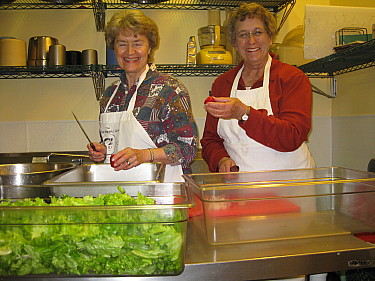
I wonder if volunteers also
did the mural outside, just a portion of which is shown below.
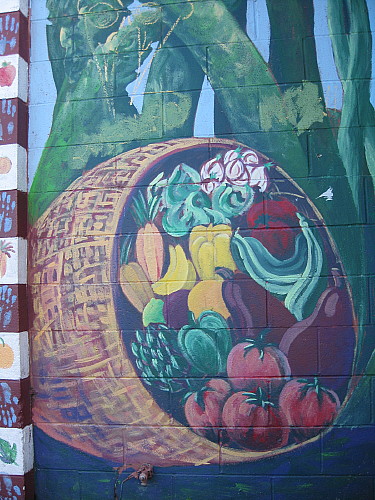
|

